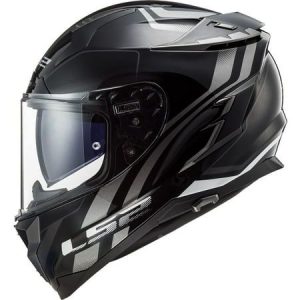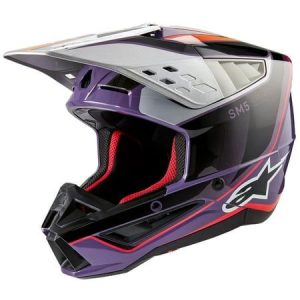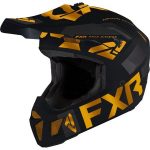For motorcycle riders, a helmet is more than just an accessory; it’s a crucial piece of safety equipment. It acts as the first line of defense in the unfortunate event of an accident, safeguarding your head from serious injury. But unlike a jacket or gloves, motorcycle helmets have a limited lifespan. So, how long exactly is a motorcycle helmet good for?
This article dives into the factors influencing motorcycle helmet lifespan, explores the telltale signs of an expired helmet, and equips you with the knowledge to ensure your helmet provides optimal protection on every ride.
Understanding Motorcycle Helmet Lifespan
Unlike food with an expiration date, motorcycle helmets don’t come with a definitive “use by” timeframe. However, several factors contribute to their gradual degradation, impacting their ability to safeguard your head effectively. Here’s a breakdown of the key influences:

- Materials: Motorcycle helmets are typically constructed from a combination of materials, including a strong outer shell (often polycarbonate or fiberglass), an impact-absorbing liner (EPS liner), and a comfortable inner lining. Over time, these materials can break down and lose their protective properties.
- Exposure to Elements: Constant UV rays from sunlight, extreme temperatures, and harsh weather conditions can accelerate the degradation process of the helmet’s materials.
- Impact and Wear: Even minor drops or bumps can compromise the helmet’s structural integrity. Scratches and scuffs on the outer shell can also weaken the helmet’s ability to absorb impact.
- Chemical Exposure: Exposure to certain chemicals, like gasoline or cleaning products not specifically designed for helmets, can damage the helmet’s materials.
The 5-Year Rule: A General Guideline
While there’s no single answer to the question of “how long is a motorcycle helmet good for?”, a widely accepted industry guideline suggests replacing your helmet every five years from the date of manufacture (not purchase). This timeframe considers the natural aging process of the materials and ensures optimal protection.
However, it’s important to remember that this is just a general recommendation. Several factors can influence the actual lifespan of your helmet, and you should replace it sooner if you experience any of the following:
Signs Your Motorcycle Helmet Needs Replacing
Don’t wait for a major accident to discover your helmet is no longer providing adequate protection. Here are some red flags that indicate it’s time to invest in a new one:

- Visible Damage: Cracks, deep scratches, or gouges in the outer shell compromise the helmet’s ability to deflect impact.
- Loose or Brittle EPS Liner: The EPS liner is a crucial component that absorbs impact energy. If it feels loose, crumbles easily, or shows signs of packing out, it’s no longer effective.
- Worn-Out or Detached Inner Padding: The inner padding provides comfort and a snug fit. If it’s excessively worn, detached, or doesn’t secure the helmet properly, it’s time for a replacement.
- Difficulty Fastening the Chin Strap: A secure chin strap is vital for keeping the helmet in place during an accident. If the strap becomes frayed, damaged, or loses its ability to fasten securely, replace the helmet.
- Unusual Odors: A lingering unpleasant odor within the helmet can indicate a buildup of sweat, bacteria, or mildew. While a thorough cleaning might address this issue, it also suggests the helmet liner may be nearing the end of its lifespan.
Finding the Perfect Replacement Helmet
Once you’ve determined it’s time to replace your helmet, prioritizing safety and choosing the right fit are paramount. Here are some key considerations for selecting your new helmet:

- Helmet Safety Rating: Look for helmets that have earned high safety ratings from independent testing organizations like Snell Memorial Foundation or the Department of Transportation (DOT).
- Helmet Type: Different helmet styles cater to various riding styles. For example, full-face helmets offer the most comprehensive protection, while ¾ helmets provide more ventilation for warmer climates.
- Comfort and Fit: A comfortable helmet is essential for long rides and encourages consistent helmet use. Try on different helmets to ensure a snug, yet comfortable fit that doesn’t restrict your movement.
- Ventilation: Proper ventilation allows for airflow, reducing sweat buildup and keeping you cool on hot rides.
Invest in Your Safety: Don’t Compromise on Your Helmet
A motorcycle helmet is an investment in your safety, and there’s no substitute for a properly functioning helmet. By understanding the factors influencing helmet lifespan, recognizing the signs of an expired helmet, and replacing it promptly, you ensure you’re equipped with optimal protection for every ride.
Don’t gamble with your safety. Visit your local motorcycle gear store today and browse their selection of high-quality, safety-rated motorcycle helmets. Find the perfect helmet that offers the right balance of protection, comfort, and style for your riding needs. Remember, a new helmet is a small price to pay for the peace of mind of knowing your head is well-protected on every adventure.
Here are some additional tips to maximize the lifespan of your motorcycle helmet:

- Store Your Helmet Properly: When not in use, store your helmet in a cool, dry place away from direct sunlight and extreme temperatures. Avoid hanging it by the chin strap, as this can put strain on the strap over time.
- Clean Your Helmet Regularly: Use a mild soap solution and a soft cloth to clean the helmet’s exterior. For the inner liner, follow the manufacturer’s cleaning instructions, which may involve removable and washable pads. Avoid harsh chemicals or abrasive cleaners.
- Inspect Your Helmet Before Every Ride: Take a few minutes before each ride to inspect your helmet for any signs of damage or wear and tear. Pay close attention to the shell, liner, and chin strap.
Ride Safe and Ride Smart: Make Helmet Safety a Priority

By prioritizing helmet safety, you’re taking a significant step towards enjoying safe and responsible motorcycling. A quality helmet is a crucial piece of gear, and with proper care and maintenance, it can provide years of reliable protection.
Don’t wait until it’s too late. Schedule a visit to your local motorcycle gear store today. Their expert staff can help you find the perfect helmet that fits your style, budget, and riding needs. Invest in your safety – your head will thank you for it!


